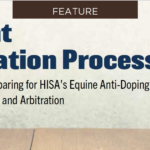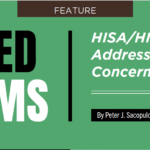More Challenges. Complicated obstacles await HISA medication regulations due to start Jan. 1.
By Clara Fenger, DVM, PHD, DACVIM; Peter J. Sacopulos, JD, Kimberly Brewer, DVM, MSC, Jacob Machin, MS; and Thomas Tobin, MRCVS, PHD, DABT
The industry is bracing itself for a seismic shift in the regulation of medications in Thoroughbred racing as a major deadline quickly approaches. The long-awaited Horseracing Integrity and Safety Authority (HISA) standards for medication and anit-doping control as well as the adjudication process expected to be in effect January 1, 2023.
HISA recently posted the version submitted to the Federal Trade Commission on its website, and clearly as much in-depth knowledge and understanding of racehorses and horsemanship went into this set of regulations that went int effect July 1.
The rules and adjudication process are outlined in the “Equine Anti-Doping and Controlled Medication Protocol” (Series 3000), “Prohibited List” (Series 4000) and “Arbitration Procedures” (Series 7000). These rules were developed by HISA’s Anti-Doping and Medication Control (ADMC) Committee, compromised of six members, of which no member, of which no members is an equine pharmacologist and only one has ever been a veterinary practitioner with racetrack experience.
The mandate for the ADMCI section of the Horseracing Integrity and Safety Act (the Act) can be found in 15 U.S. Code 3055(b) and requires, among other things, that “(1) Covered horses should compete only when they are free from the influence of medications, other foreign substances, and methods that affect their performance (2) Covered horses that are injured or unsound should not train or participate in covered races, and the use of medications, other foreign substances, and treatment methods that mask or dreaded pain in order to allow injured or unsound horses to train or race should be prohibited”
The ADMC Committee far exceeded this mandate in crafting its regulations. Substances are banned well beyond their ability to “influence performance” or “allow unsound horses to train or race”. The term “covered horse” includes all horses between their first published work and retirement. While many can read the list of prohibited substances and agree that “yes, that shouldn’t be in a racehorse,” a covered horse includes not only racehorse but horses on layup, horses that have had surgery and horses in the recovery period after surgery. Many of the substances that really have no use in a horse actively training and racing have very important value in horses on layup. The many years that have gone into the development and modification of the Association Racing Commissioners International (ARCI) medication standards, during which numerous veterinary pharmacologists and chemists provided input, have been completely ignored. In contrast, the ADMC Committee scrapped the ARCI standards in favor of a new program based on zero tolerance.
To read more of the changes coming in January 1, 2023, make sure you download the publication in full – Fall 2022, Horseman’s Journal






